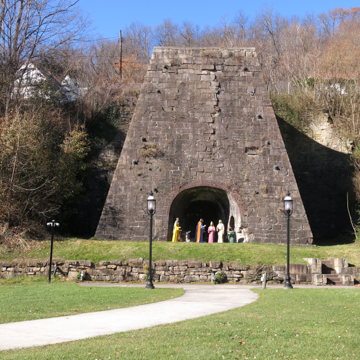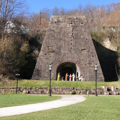Emblematic of the significance this region once held in the nation’s iron industry is its only remaining iron furnace. Known historically as George’s Creek Coal and Iron Company Furnace No. 1, it was the first furnace in the country to successfully demonstrate the use of coke and raw bituminous coal to fuel iron production. Smelting and casting began here in 1839, producing goods such as stoves, agricultural implements, machine parts, and dowels for the C&O Canal’s lock walls. In 1845, it was leased to German-born engineer Christian E. Detmold, who developed a method of using furnace gases to heat the blast, producing about 2,500 tons of pig iron per year. Depletion in iron ore deposits caused operations to cease in 1856. Nonetheless, it provided the model for others in western Maryland.
Along with Mount Savage and Frostburg, Lonaconing formed the center of iron production in Allegany County. In fact, the presence of the iron furnace was the basis for its establishment as a company town, which now proudly displays the restored structure within a community park. The fifty-foot tall cut stone and brick furnace is set against a hillside retaining wall to facilitate the loading of ore and coal from the top into the firebrick-walled furnace chamber. Molten iron was discharged through the alcove at its base, while the flanking tunnels provided access to the furnaces, steam engines, boilers, and air compressors.
Adjacent is the unusually decorative Georges Creek Coal and Iron Company Office Building (c. 1840; 7–9 Park Street) that originally housed offices and boarded miners. It is significant as one of the earliest mining-related structures in the region, built for one of its first company towns, established in 1837.









